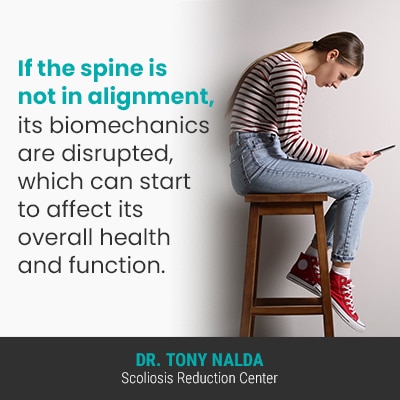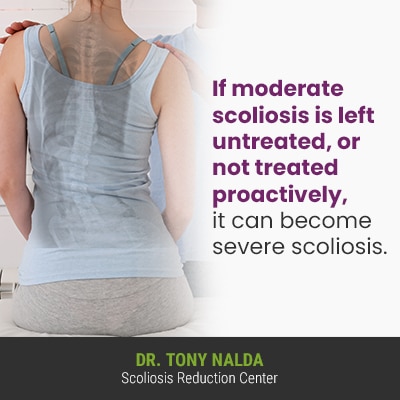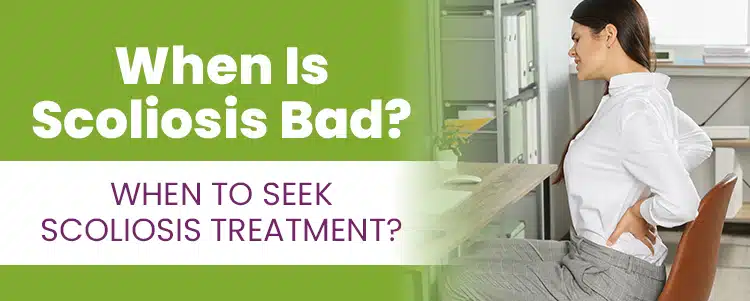Scoliosis varies widely in severity from mild to moderate and severe to very severe. Where a scoliosis is at the time of diagnosis isn’t indicative of where it will stay; only proactive treatment can counteract the condition’s progressive nature.
As a progressive condition, even if mild when diagnosed, it doesn’t mean the condition won’t get worse. The best time to start scoliosis treatment is always now. With early detection and proactive treatment, there are fewer limits to what can be achieved.
Progressive conditions like scoliosis are virtually guaranteed to worsen over time, so let’s start by defining the condition and exploring the condition’s progressive line.
How Bad Can Scoliosis Get?
First of all, being diagnosed with scoliosis means an unnatural lateral (sideways) spinal curve has developed.
To be considered a true scoliosis, the unhealthy spinal curve also has to have a rotational component, meaning it doesn’t just bend unnaturally, but also twists.
The spine’s natural curves make it stronger, more flexible, and better able to absorb stress from activity; if the spine loses one or more of its natural curves, this means one or more vertebrae have shifted out of alignment with the rest of the spine.

If the spine is not in alignment, its biomechanics are disrupted, which can start to affect its overall health and function.
An important condition characteristic about scoliosis is that it’s progressive in nature, meaning the size of the scoliotic curve is likely to increase in size, at varying rates.
It can be difficult to predict a patient’s progressive rate, but certain factors do play a role such as patient age, condition type, curvature location, and condition severity.
Condition severity is determined by a measurement known as Cobb angle, and this is taken during X-ray and tells me how far out of alignment a scoliotic spine is, and also classifies conditions by severity:
Mild scoliosis: Cobb angle measurement of between 10 and 25 degrees
Moderate scoliosis: Cobb angle measurement of between 25 and 40 degrees
Severe scoliosis: Cobb angle measurement of 40+ degrees
Very-severe scoliosis: Cobb angle measurement of 80+ degrees
Mild to moderate and severe to very severe is the condition’s progressive line, and the goal of treatment is to disrupt that line by counteracting the condition’s nature to worsen, but how is that done, and exactly how serious is scoliosis?
There are also different types of scoliosis, but the most prevalent is adolescent idiopathic scoliosis (AIS) diagnosed between the ages of 10 and 18, so this is the condition type we’ll focus on currently.
Let’s break down how scoliosis can affect the body at the mild, moderate, and severe levels, for a better understanding of why scoliosis is bad.
Mild Scoliosis
A diagnosis of mild scoliosis means a Cobb angle of between 10 and 25 degrees, and this is the first stop in the condition’s progressive line.
Again, what’s important is that as a progressive condition, it won’t stay mild without an active effort to hold it there, especially in adolescents.
In adolescent idiopathic scoliosis, the idiopathic classification means not clearly associated with a single-known cause.
Although we don’t fully understand the etiology of idiopathic scoliosis, we most certainly know how to respond to a diagnosis and what triggers its progression: growth and development.
Children and adolescents are at risk for rapid-phase progression because of the stage of puberty with rapid and unpredictable growth spurts.
Even if a condition is diagnosed as mild, most adolescents would feel anything but fortunate, but if the diagnosis is responded to with proactive treatment, there are fewer limits to what we can achieve.
Scoliotic curves are simpler to reduce when smaller, before significant progression has occurred, making the spine more rigid (less responsive to treatment), and before the body has adjusted to the unnatural spinal curve’s presence.
Scoliosis introduces a lot of uneven forces to the body, and in adolescents, the main symptom is postural deviation that disrupts the body’s overall symmetry.
Early signs of mild adolescent idiopathic scoliosis to watch out for can include:
- Head uncentered over the body
- Uneven shoulders
- Uneven hips
- Ribs protruding more on one side than the other
- When standing, there is a noticeable tilt to one side
- Arms and legs that seem to hang at different lengths
Basically, any asymmetries that seemed to have suddenly become noticeable, and/or clothing that seems to be ill-fitting, can be condition indicators and warrant the need for further testing.
The tricky thing about early detection of AIS is that as the condition doesn’t become compressive until adulthood, it’s not commonly painful, whereas for adults, compression of the spine, and its surrounding muscles and nerves, is painful; pain is the number-one symptom in adults.
So in order to achieve the benefits of early detection, this means getting treatment started as close to the time of diagnosis as possible because this is when the condition is going to be the most responsive to treatment.
If left untreated, at some point, mild scoliosis is likely to become moderate scoliosis, and this is when many of my patients are first diagnosed because the signs and symptoms of mild scoliosis can be subtle and difficult for anyone, other than an expert, to notice.
Moderate Scoliosis
When a condition has progressed from mild to moderate, the postural changes tend to be more noticeable, and while younger patients who are still growing don’t experience the painful effects of compression, there is also related muscle pain.
As a condition progresses, this means the scoliotic curve is increasing in size, which means the condition’s uneven forces are also increasing, and it’s not just the spine that’s in charge of maintaining its healthy curves, but also its surrounding muscles.
The core muscles that support the spine can become tight and sore as a result of straining to support the unnaturally-curved spine, and in addition, muscles can become imbalanced: stronger on one side than the other, again, due to the condition’s uneven forces.
When moderate, the postural changes that start in mild scoliosis are more noticeable and pronounced, and can also include:
- The unnatural spinal curve being visible to the naked eye
- The development of a rib arch that’s more noticeable
- Overt uneven shoulders and hips
- Shoulders becoming more uneven, including the shoulder blades
In addition, at this level, changes to coordination, balance, and gait are also more prevalent.

If moderate scoliosis is left untreated, or not treated proactively, it can become severe scoliosis.
Severe Scoliosis
The more scoliosis is left to progress, the more severe it’s likely to get; the more tilted the vertebrae become, the less able they are to stay in alignment, and a spine that’s becoming increasingly misaligned won’t function as it should, especially at this level.
Now, for those on the traditional path of treatment, this is when spinal fusion surgery is often recommended, and while all surgical procedures come with risks, spinal fusion is a costly and invasive procedure that carries some heavy potential risks, side effects, and complications.
I believe in being proactive with treatment so patients don’t even experience progression into the severe level, the hardships associated with severe scoliosis, and the need for invasive surgical treatment.
While each case is unique, the symptoms of severe scoliosis include:
- Noticeable levels of postural deviation
- Varying levels of back pain
- Varying levels of muscle pain
- An unnatural spinal curve that’s visible to the naked eye
In addition, if left untreated, severe scoliosis can cause some complications:
- Headaches that can reach migraine status (due to disruptions to the flow of CSF)
- Lung impairment
- Digestive issues
- Bowel/bladder issues
When it comes to overall health and wellness, prevention is key. Why not be proactive with scoliosis as well? And what is the prognosis of scoliosis? The answer will depend on precisely how a patient’s diagnosis is responded to.
If responded to proactively, and especially with early detection, the condition can be highly treatable, so the best time to seek scoliosis treatment is always now, but what exactly does scoliosis treatment entail?
How is Scoliosis Treated?
Now that we’ve explored the different levels of scoliosis severity, the answer to should I worry about my scoliosis is yes, it should be a concern, but responding proactively can minimize the condition’s effects and help avoid increasing condition severity and escalating symptoms.
There are two main scoliosis treatment approaches for patients to choose between: traditional and conservative.
Depending on which approach is committed to, potential results can vary widely, and while those who opt for traditional treatment are commonly recommended to merely watch and wait, following a diagnosis of mild scoliosis, my response is to start treatment as close to the time of diagnosis as possible; I don’t believe in wasting valuable treatment time.
Here at the Scoliosis Reduction Center®, I’m asked many questions following a diagnosis of adolescent idiopathic scoliosis.
From how severe is my scoliosis to what is the prognosis for someone with severe scoliosis, and the answer depends on a number of key variables such as patient age, condition type, curvature location, condition severity, and the chosen treatment approach.
I don’t want patients to experience a spine that’s less functional because of how it was treated, and the reality is that many patients experience a noticeable loss in spinal health and function following spinal fusion, whereas patients who achieve treatment success through a modern conservative chiropractic-centered treatment approach have as much natural spinal function preserved as possible, and this is because:
- Condition-specific chiropractic care can involve manually adjusting the most-tilted vertebrae, at the curve’s apex, back into a healthier alignment with the rest of the spine
- Physical therapy can increase core strength for better spinal support from surrounding muscles
- Corrective bracing can augment corrective results by pushing the spine into a corrective position
- A series of custom-prescribed scoliosis-specific exercises/stretches can help patients establish a home-rehabilitation program to further stabilize the spine
By integrating these different treatment disciplines, conditions can be impacted on every level, and as scoliosis is a structural condition, it primarily has to be impacted on a structural level, through chiropractic care.
Scoliosis no longer has to define a person or dictate the path of their life, especially if responded to proactively.
Conclusion
Scoliosis is bad because it introduces uneven forces to the body, and the spine is a key structure of human anatomy; it allows us to stand upright, practice good posture, engage in a variety of flexible movements, gives the body structure, absorbs stress incurred during activity, and works in partnership with the brain to form the body’s central nervous system (CNS).
Keeping the important roles of the spine in mind, it’s understandable how spinal conditions like scoliosis can cause such a wide range of affects that aren’t just isolated to the back.
So is scoliosis very serious? It certainly can be, especially if left untreated, or not treated proactively.
Scoliosis ranges widely in severity from mild to moderate and severe to very severe, and where a scoliosis is at the time of diagnosis is not indicative of where it will stay; only proactive treatment can work towards counteracting the condition’s progressive nature.
Patients of the Center benefit from an integrative treatment approach that involves customizing treatment plans to address key patient/condition variables for the best potential results.
So when should a person seek out scoliosis treatment? If wanting to avoid increasing condition severity, and all that comes with it, the answer is always now, so don’t hesitate to reach out for support and guidance.




